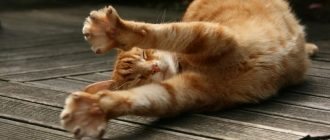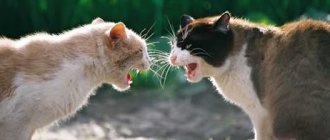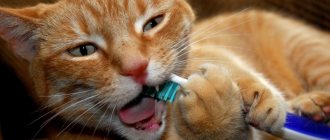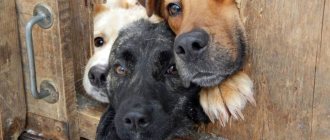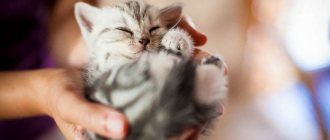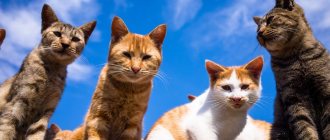The animal's postures and gestures, such as the tongue of a cat's tail, are in most cases well understood by hobbyists. Those owners who have just started communicating should learn what this or that movement means. A cat expresses its emotions in ways accessible to it: with its head, ears, paws, tail, meowing, tongue, characteristic sounds, a combination of gestures and behavior. Sometimes special attention is required so as not to miss a signal about the disease.
Voice signals
Most often, cats convey information using their voice. This is how they protest, threaten, beg for a treat, or attract attention. For each situation, the cat has a corresponding set of sounds. The vocal abilities of cats are very impressive. In terms of pitch, the animal can produce sounds in the range from 75 to 1520 Hz. Fear and aggression sound “low,” while higher sounds are used to express pleasure and tenderness. The mother cat generally communicates with kittens in the ultrasonic range, which the human ear cannot perceive.
There are at least sixteen different sounds used by cats. Moreover, the “talkativeness” of a cat may depend on the breed. For example, Siamese and Oriental cats “communicate” most often. Purring and rumbling are generally characteristic only of small cats; their larger counterparts practically do not use such sounds.
The purr of a cat is a symbol of sympathy and good-natured disposition. Purring, the cat calls the kittens. Rumbling, on the contrary, warns kittens about danger, and the cat also communicates its aggressiveness and readiness to get into a fight.
Oddly enough, hissing is not a sound of aggression, but rather a symbol of fear and the inability to escape. If snorting and hissing are accompanied by forward movement of the body, this is a signal for a fight. But more often, snorting indicates doubt: fight or run?
Cats rarely resort to a signal such as teeth chattering. Basically, this is a reflex when seeing prey that is out of reach of the animal. The cat chatters her teeth when she teaches her kittens to hunt, literally “I see prey!”
A cat's meow is a conversation. Vowel sounds express a request, complaint or bewilderment, for example, “let me out”, “I’m hungry”, “I’m bored”, “help”. Each cat is individual in the manner of meowing.
Newborn kittens acquire their “vocal” abilities gradually, learning from adult animals. As a rule, a kitten can produce a full range of sounds by the age of three months. Further, the palette of sounds can be enriched under the influence of personal experience, training and the external environment.
With mouth opening and closing
Varies greatly in duration and height; can express a demand for attention, help, food, etc. The most common, varied and difficult signal to interpret.
One of the most unpleasant signals that haunts us during the time of “cat weddings”. Long howling sounds are made by animals ready to fight (sometimes in duets), expressing threat, rage and fear.
A long series of sounds - something between a howl and a meow - are used by both male and female cats to announce themselves to potential partners for the purpose of having offspring.
Accents
Establishing a connection with humans, cats changed the tone of their meows and the timbre of their purrs. But if so, then perhaps they are capable of more “fine” tuning of sound signals in accordance with the habits and characteristics of their two-legged owners? Swedish linguists and zoologists from Robert Eklund's team are working on this issue. In 2016, they launched the MEOWSIC research project to determine how the sounds cats and people make when communicating with each other change. Perhaps, listening to the peculiarities of the sound of human speech, trying on a particular situation, animals change some subtle features of their signals?
Scientists have already collected audio and video recordings of several dozen cats and their owners living in Sweden. More than a thousand samples of meows and other vocalizations are processed using algorithms that should identify sets of frequencies and durations, melodic and timbre colors characteristic of each cat “word.” At the next stage, this will allow you to check how the “accents” of cats of different breeds from different areas relate to each other.
Perhaps the cats in Lund speak differently from those in Stockholm: local dialects of Swedish are noticeably different, and cats can adapt to them in order to achieve a better understanding from their owners. In the end, kittens of different breeds really differ in behavioral strategies, mobility and general character - and nothing prevents them from emitting different sound signals. However, the question of how much this helps to understand them remains open.
Misunderstanding
Back in 2003, Nicholas Nicastro and Michael Ouren demonstrated that people have great difficulty figuring out why a cat is meowing, and perform only slightly better than if they answered at random. Owners interpret the sounds of their pets a little more confidently and are a little better at indicating what exactly the animal is trying to convey, whether it requires attention, whether it is waiting for food or help. However, they determine the meaning of the meowing of unfamiliar cats with an accuracy not exceeding random. Having learned to manipulate the DNA code and reached the Moon, we still have little understanding of our pets.
Cat facial expressions
Cats also transmit many signals through their facial expressions. Unlike the sound scale, facial expressions and gestures are innate. Newborn kittens already “know” the meaning of facial expressions and gestures at the level of instincts and use them adequately.
Cat facial expressions are very expressive and varied, thanks to the extraordinary mobility of the facial muscles of the face and head. And cat's eyes very clearly reflect the mood of the animal. For example, half-closed eyes indicate peace and relaxation, while wide open eyes indicate interest or concern. Dilated pupils - fear, squinted eyes and staring - a challenge. A cat's gaze averted to the side signifies submission. If the pupils sharply constrict and the cat is concentrated on one object, it is ready for aggression.
A cat's ears can also tell a lot. If the ears are facing forward, the cat is relaxed, interested, or greeting someone. Ears pressed to the sides of the head indicate pronounced aggression; ears pulled back and pressed to the head indicate fear and confusion. Nervous twitching of the ears means that the cat is irritated or unsure of itself.
Cats can move their eyebrows and whiskers and use this facial expression to communicate. If the whiskers point forward, the cat is interested, excited, or ready to act. The mustache is spread out on the sides of the head - calmness. Hairs are collected in bunches and pressed to the cheeks - fear or anxiety.
A contented, calm cat keeps its mouth closed or slightly open. By the way, the protruding tip of a relaxed tongue is a sign of supreme bliss and complacent disposition. The mouth is open, the lips are raised in a grin - the cat is about to attack. A “grin” in a cat, oddly enough, means that the animal is studying the smells that interest it, especially those of other individuals of the opposite sex. A long full-mouth yawn means complete relaxation, but a quick licking of the lips, on the contrary, is a symbol of anxiety or confusion.
If a cat rubs its head or its whole body against you, or, as they say, gets under your feet, it is showing a feeling of sympathy. Sometimes this may mean asking for something. For example, about reciprocal affection. Is your cat rubbing its forehead against you? This is an element of intimate affection, a symbol of the highest affection for the owner.
Paws and the position of claws also mean a lot in a cat's language. In a moment of irritation or anxiety, a cat may strike sharply with its front paw. The claws are not released; this strike is preemptive in nature. A soft touch with claws drawn indicates affection. Handling the front paws, coupled with purring, is an expression of satisfaction. This gesture is preserved in adult animals from a very early age, when in this way the kitten massages the mother's nipple while eating.
Why don't animals talk?
Representatives of the fauna cannot maintain a conversation for several reasons. In addition to the fact that they do not have such a need, there are also physiological obstacles:
- Pronouncing words clearly requires a well-functioning organ system. In mammals it is not provided.
- The ability to speak and understand language is formed as a person develops logical and associative thinking skills. Animals do not have such talents.
One of the important human qualities is the ability to invent new terms. In the communicative practice of animals, this occurs only among especially gifted monkeys who use sign language.
The tail is the most important way to transmit information
Features of communication in the animal world
There are many nonverbal communication methods in the animal kingdom. Each species speaks its own language, which is a simple system of signals.
Table 1. Signal system
| Method | Characteristic |
| Touch | Monkeys show affection through skin-to-skin contact by picking through fur or searching for fleas. Ants tickle their fellow ants with their antennae, which is a signal that milking is necessary. |
| Release of odorous substances | The most common. It is used primarily to mark the boundaries of a territory and for navigation purposes. Both the secretions of the genital, accessory, and sebaceous glands, as well as urine, are used. Scout bees, for example, emit a scented substance on their way to a food source. This helps others find their way to the feeder. |
| Color effect | This tool is used mainly during the mating season or to scare away the enemy. In spring, the frogs' bodies become brightly colored to attract a partner. The color of male birds and fish, driven by sexual instinct, also becomes more saturated. In addition to ingratiating themselves with females, color is used as a weapon to scare away the enemy. |
| Language of the body | Among the body parts involved in transmitting information, the tail plays an important role. This is especially true for representatives of the cat and canine families. In addition, arching of the back, flattening of the ears, beating with hooves, and punching the chest are popular. The behavior of bees is interesting. To report the location of food, they use their body to describe the letter “O”, meaning that the food is close, or the number “8”, indicating a further distance. |
| Facial expressions | This method is popular among large mammals. Tightly closed jaws mean intimidation, furrowed eyebrows mean a threat, bared fangs mean readiness to attack, and a protruding tongue means a desire to communicate. |
| Sound signals | The sound code of the animal world is very diverse. In addition to birds, this instrument is actively used by quadrupeds to convey fear, rage, pain, pleasure and other emotional states. |
There are also less common methods of communication - the bioelectromagnetic fields of the Nile elephant, high-frequency signals in dolphins, echolocation in bats.
Elephants communicate with each other using infrasound signaling
Body movements
The most visible part of a cat's body is its tail. It is he who expresses the cat's feelings and emotions most clearly. Only by the tail can one judge the cat’s states and intentions. The tail is raised up - your pet is in a good mood, friendly and ready to communicate. Kittens' puffy tails are a symbol of their interest in the world around them. A raised tail is a call to play.
If the tail, on the contrary, is lowered and tousled, this means that the animal is alert. But if the fur is raised only at the base of the tail, the cat already knows what to do in this situation. Severe fear is expressed by the tail tucked between the paws.
An aggressive animal can be recognized by a highly raised, tense, tousled tail in a dominant animal and a lowered, arched tail in subordinates. A horizontally extended tail twitching rhythmically is a sign of irritation, but if the tail is knocking on the floor, the cat is more likely to be scared. If the amplitude of movements increases, and the animal literally whips itself on the sides with its tail, this is pronounced aggression.
Depending on how fast and what part of the tail the animal moves, emotions are determined. For example, a slight waving of the tip of the tail indicates relaxation; at first, a slow, and then increasingly rapid swing of the tail occurs before jumping on the object of the hunt.
The cat's pose expresses its own state, and also depends on who it is addressed to. The pose when seeing a strong opponent is different from the pose with which a cat meets an aggressive fellow tribesman. The threat pose allows the cat to look larger and more impressive: the legs are extended, the animal stands on tiptoes, the back is arched, the tail is curved, the hair stands on end. In an excited or frightened cat, the cheek nodules move, the hair on the cheeks bristles. The threatening pose is complemented by ears pressed to the back of the head, the nose is wrinkled, the fangs are exposed, and the corners of the mouth are drawn back. The cat purrs and hisses.
Cats sense the threat distance well: the distance from the enemy to the cat that no longer feels safe. Usually the animal prefers to flee, although it takes a threatening pose. But if the cat is cornered and cannot escape, and the threatening pose has no effect and the enemy continues to approach, the cat rushes to attack. This distance is called the “distance of aggression.” But for a mother cat there is no difference between “threat distance” and “aggression distance”; she will not run, but sees the enemy from afar. The cat rushes towards the enemy, jumps on all four legs, straight and outstretched, while remaining turned sideways to the enemy, the tail is raised high and fluffed. Such a cat is ready to fight to the death to protect its offspring.
In relationships with aggressive fellow cats, cats use other postures. The animal practically does not hunch its back and does not bristle its fur, but only slightly fluffs it on the withers and tail. Distance is not particularly important; the animals stand nose to nose, looking into each other's eyes, howling and purring. Cats try to remain motionless in order to suppress the enemy's morale, but the blows of the tail on the sides mean that the animal is ready to rush into a fight at any second.
When the fight begins, the first blow with the paw lands on the opponent's nose. The attacker then tries to bite the back of the opponent's head, and if this succeeds, the opponent falls on his side. A cat that does not want to engage in a fight takes a pose that combines elements of submissiveness and threat: the animal presses into the floor, lies on its side or back, putting its paws forward with its claws extended. The winner of the fight is eliminated first, trying to retain as much dignity as possible.
When communicating with people, cats rarely carry out their threats. Animals have developed inhibitions that inhibit aggression towards the owner. But if the animal is threatened by a stranger, the cat will aggressively defend itself and can seriously injure the person.
The most graceful demonstration of contentment and complacency is when a relaxed animal lies down, showing an unprotected belly. The paws are spread out to the sides, the claws are hidden, the pads can be compressed and unclenched. The eyes are half-closed, the pupils are constricted. This pose demonstrates complete trust, since the stomach is the most vulnerable place on the body.
Cats show indecision in a very interesting way. This condition is always accompanied by licking of fur. The more decisively the cat licks itself, the more serious the problem it solves at that moment. Licking calms the animal, neutralizes irritability and possible aggression. Cats often lick their cubs, other animals and even their owners, showing their affection and calling for calm.
The emotions of the owners are transferred to the animals. Nervousness, tension, the appearance of a small child who makes the cat jealous can lead to pathological behavior of the animal, expressed in the fact that the cat licks itself until certain parts of the body are completely bald.
Can a cat understand a person?
When communicating with people, cats remember gestures, looks and voice of the owner that correspond to certain situations. You beckon your pet with your hand, calling his name, and he follows you. You slapped him lightly on the leg and he climbed onto your lap. Over time, he responds to his name and understands the meaning of some words. The longer your pet lives with you, the more he learns your lifestyle, habits and character weaknesses.
Cats show amazing ingenuity to get food:
- open the pan by sliding the lid with your paw;
- can open the refrigerator or cabinet door;
- hiding in the kitchen unnoticed by the owners;
- can learn to eat from an automatic feeder;
- open the water tap.
In countries where many cat owners live in private homes, such as Italy or the UK, cats know how to use a door knocker. After knocking, the animal sits and waits patiently for the door to be opened. In apartment buildings, a cat announces itself by pressing the doorbell button with its paw.
Domestic cats are willful and independent creatures who know how to show their owner how they feel through their behavior. And they will always make it clear that you are obliged to take them into account. Let me give you an example. Summer day, day off. In the morning, my cat and I go outside, each going about our own business. I'm going to take her home by lunchtime. One does not walk so as not to irritate the neighbors. I go out and she is fast asleep on a thick branch of an apricot tree. Lies on his stomach, head extended, both right paws hanging freely on one side, and the left, respectively, on the other. Shade, pleasant coolness, leaves rustling and sparrows chirping. She went up to the tree and called. The cat opened one eye to make sure it was its owner. She closed it and went back to sleep. I tell her I'm going home and I'll give her lunch to the other cats. I stood up, stretched, sat on a branch and beat my tail - I won’t go! I didn’t wait, I went into the entrance and walked up the steps. Second floor. I put my foot on the next one - and I hear a quiet, high-pitched “meow” outside the door. She came anyway. I went down, opened the door for her, and we went home together. I feel like she’s offended and doesn’t look at me. And indeed, she didn’t go to the bowl, she jumped into her place, sat with her back to me and licked herself. If you approach her at this time and extend your hand to stroke her, a lightning strike with a clawed paw will follow. Only in the evening she went to eat and the conflict was settled.
Another time, also in the summer, we washed her, dried her and in the evening we went for a walk with her. Thirty degree heat. She plays, jumps after insects, hides and runs from tree to tree. We walk back along the path and are speechless. Our pure, clever girl is bathing in a pile of sand, and with such excitement that it flies in all directions. Her fur fluffed up, her tail wriggled like a snake, her satisfied eyes sparkled: “I don’t need to be washed with water, okay?!” I had to clean her fur again.
Of course, there will always be cases when a pet’s behavior or the sounds it makes are so unusual that even a specialist cannot “translate” them. Surprisingly “talkative” cats have made themselves and their owners famous on the Internet. Many users watch videos of such cats.
Video: a cat stands at a closed door and says: “Open it!”
Poses
With their appearance, cats can demonstrate not only friendliness, humility and harmony, but also resentment, pride, and arrogance. As soon as you yell at a pussy for some offense, it will immediately become offended, turn its back to the owner and stop responding to its name. But in fact, this is how the cat simply “switches off” from the stimulus.
READ Breed standard weight and size of dachshund
You can often notice how one of the ears of a sleeping cat turns slightly and the tip of its tail trembles a little
This means that something has attracted her attention, and she is too lazy to turn around and look at the source of the sound, but curiosity haunts her
123RF/lithian
When a cat hunts, he gets all up, stretches his tail into a string, and puts his muzzle forward, his ears are alert, his gaze is intent and unblinking. The animal begins to fidget slightly in place, sways and suddenly rushes forward.
If a cat bends down to the floor and also presses its whiskers and tail to appear smaller, then it is not in the mood and wants not to be touched.
By lying down and turning over on its back, the pet demonstrates the highest degree of humility and trust. The stomach is the most vulnerable place for cats, so they can only allow people they completely trust to scratch it.
If a cat crouches with her front paws to the ground, puts her butt back, tramples with her hind paws, and moves her tail to the side, purring at the same time, this means that she is in heat. When a cat turns its back to a vertical surface, lifting its tail, and shakes it slightly, then in this way it “marks” objects with an unfamiliar smell.
Paws
You can often observe how a cat shifts its paws, slightly releasing its claws, and purrs at the same time. Such movements remind him of the times of childhood, when he kneaded his mother’s belly with his paws and sucked milk, and mean the highest bliss and happiness. 123RF/Alena Ozerova
Having settled on the owner's lap, the animal falls into childhood. Under no circumstances should you drive him away. This is a moment of great love and affection, and the behavior of the owner, angrily driving him away from his lap, is inexplicable for the cat.
A raised clawed paw means that the animal is expressing dissatisfaction and irritation or is trying to defend itself. During a fight, a cat can fall on its back in order to “take up defense” and fight off the enemy with all four paws, especially its hind legs - they are stronger.

